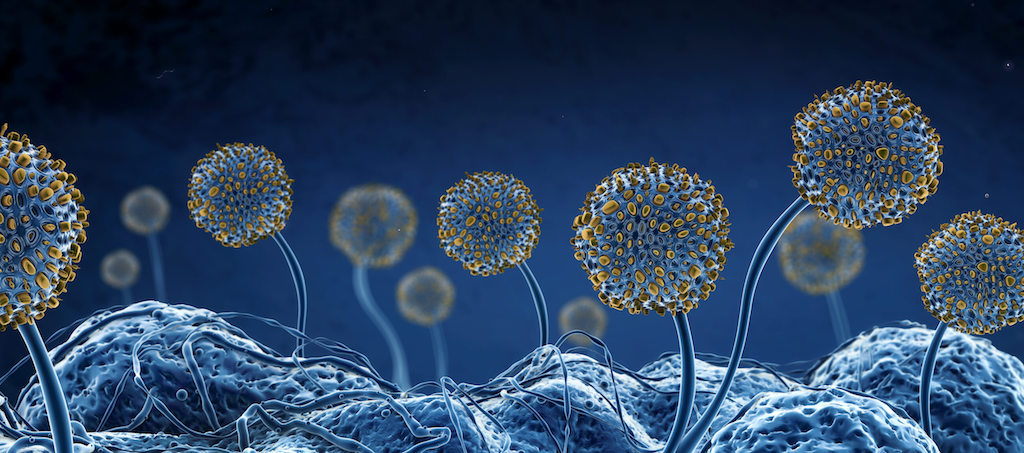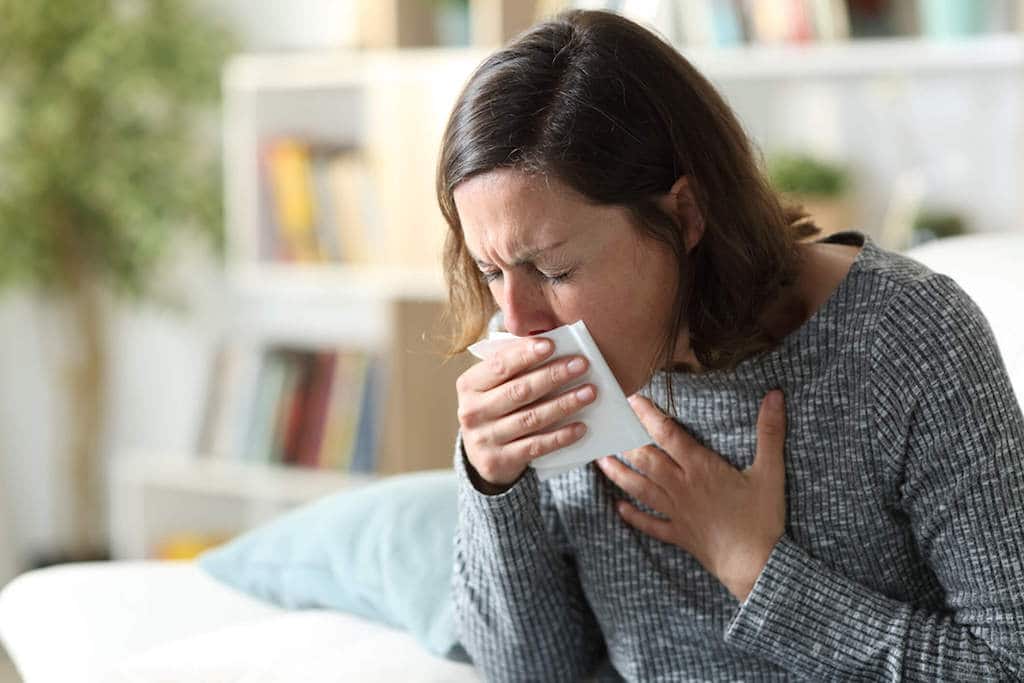No products in the cart.
Mold growth can happen to anyone’s home. One day you’re living your life in mold-free bliss (or you think you are) and the next day you’re staring at a moldy Rorschach inkblot test near an air vent in your ceiling. The issue, other than that initial sinking feeling in your gut, is that when you see visible mold in your home, chances are it’s a bigger problem than the small portion you’re looking at.
It’s just the tip of the moldy iceberg.
Why is that and what do you do next? Understanding that will help you realize the full scope of the mold exposure in your home and how it can (if it’s not already) affect your health.
MOLD’S LIVING STANDARDS
Molds are hardy little fungi that don’t need a lot to survive and thrive.¹ Impressive in nature, but a nightmare when in your home. The key thing to remember here is that mold exists in every home, but not in colonized versions.

Molds produce microscopic spores that float through the air looking for a place to call home.² They’re similar to seeds except you can’t see them; spores are 25 times smaller than the naked eye can see.
A couple of spores floating around your house won’t cause damage, but if they find suitable conditions to hunker down in and grow… that’s when they create an entire civilization. When you factor in that there are tens of thousands of mold species that can grow in all different environments, you start to understand how easy it is for mold to develop in homes and why visible mold is a problem.
PRIME CONDITIONS TO SUPPORT MOLD GROWTH ARE:³
1. Oxygen: Like most living organisms, molds need oxygen to grow. This one is a pretty easy checkmark when it comes to living inside a home.
2. Correct temperature: Most molds thrive in temperatures between 60 and 80 degrees Fahrenheit, but can survive in temperatures between 40 and 100 degrees. Most homes are kind enough to keep the temperature inside controlled between 60 and 80 degrees which is the perfect, welcoming embrace for these fungi. ⁴
3. Food: Molds eat pretty much anything, including what they’re growing on. They can eat dust, dander, dead skin cells, wood, carpet, etc. One thing they are not is picky.
4. Moisture. This aspect is key for beginning mold growth. Most think of a continual leak when it comes to spurring mold development, but that’s just one potential option. It could be as simple as a slightly damp piece of carpet, but if it’s wet for around 48 hours, mold can settle in and settle down for the long haul.
When all of these circumstances are met, and it’s easy to accomplish, molds flourish. And as they flourish, molds reproduce and send more and more spores into the air to find other habitable areas in a home. Areas like coffee makers, showers, inside walls, or a tiny wet spot in the attic.
As they continue to spread, the air quality in a home takes a drastic downward turn and not just because of the density of spores. Many molds also produce mycotoxins: microscopic toxic compounds that also float through the air and are even harder to treat once they adhere to a surface. The combined effect of these microorganisms, as well as the potential for bacteria depending on where the water source was, can have drastic impacts on our health.
MOLDS AND HEALTH
Research remains ongoing to determine the extent to how molds can affect health because they can cause such a wide array of symptoms. Pre-existing conditions also have an effect on the development of health issues. Some individuals are highly sensitive to molds, such as the immunocompromised, and experience symptoms quickly. Others take a while to reach the “toxic load” in their bodies, which is the threshold their body reaches when it cannot keep up with the number of particulates it’s exposed to.

SYMPTOMS RANGE FROM IRRITATING:
Brain fog
Coughing
Fungal Infections (like Athlete’s Foot)
Fatigue
Congestion
Runny Nose
TO MORE SEVERE SIDE-EFFECTS:
Respiratory Issues
Digestive Issues
Neurological Problems
Immunosuppression
Chronic Fatigue
Joint Pain
My Mold Talks go into deeper detail with real individuals that experienced mold exposure and their journey to recovery. Many people, though, never even saw mold in their homes. They just experienced the health effects. That’s why those who see visible mold in their houses need to complete thorough inspection and remediation to make sure the entire iceberg is taken care of, not just the tip. We all saw how the Titanic went… No one wants to be taken down by the larger unseen threat underneath.
TREATMENT: VISIBLE MOLD AND UNSEEN MOLD
FINDING AN INSPECTOR
With the cornucopia of misinformation out there, we all need to focus on building mold awareness so that we can treat the problem properly. If you see visible mold growth, chances are it’s not just that single problem. You need to find a mold inspector that will create a detailed roadmap of the mold in your home.
This inspector should spend a few hours test for:
- Types of molds present
- Quantities of each mold
- Potential spore presence in the HVAC system
- Presence of mycotoxins (a harmful toxin produced by molds)
- Presence of bacteria
This information will determine how bad the exposure is and the extent of remediation needed. The data collected can also be used for aiding in diagnosis. When mold is already present, chances are individuals in the home are experiencing some sort of symptoms, whether it be brain fog or something more severe like digestive issues. Knowing what’s in a home can help doctors determine what the body’s struggling with and help build a better-suited detoxification treatment.⁵
FINDING A REMEDIATION COMPANY
Remediation is time-consuming and situational. No two homes are completely the same when it comes to mold growth, due to aspects like location or source of the problem. Remediation teams need to be fully equipped to understand the full scope of the mold problem, but or importantly, they need to make the health of those living in the home the top priority. That way, if they leave and health continues to deteriorate or mold growth pops up again, they’ll come back to finish the job.
THE THREE KEY PILLARS A MOLD REMEDIATION COMPANY SHOULD ADHERE TO ARE:
- Identify the source of water/moisture that allowed for mold to grow in the first place
- Remove the source of the problem
- Clean up the contamination created by the source
HomeCleanse’s Mold Remediation Process page also provides a list of questions to ask remediation teams to ensure they’re the best company for the job.

THE MOLDY ICEBERG
Finding visible mold can be disheartening. Remediation is costly and can take extended periods of time when done correctly because as I’ve mentioned, the mold you see is almost positively indicative of a bigger problem. Not to mention the effects molds and toxins can have on health.
That’s why prevention and mold awareness is so important. Stopping the problem before it starts can save money, prevent illness, and provide peace of mind.
A FEW STEPS TO TAKE TO STOP MOLD FROM EVER TAKING ROOT INSIDE A HOME ARE:⁶
- Regularly inspect the roof and windows for leaks
- Keep the indoor humidity level low
- Keep those windows closed on rainy and humid days
- Prioritize that HVAC system- keep it clean, dry, and running smoothly
These methods may cost money upfront, but let’s be honest, they’re worth a mold-free home! We as a society need to focus more on mold awareness so we can all live healthier and happier lives. And most importantly, create lives without those moldy icebergs!
- Environmental Protection Agency. (n.d.). Mold . EPA. https://www.epa.gov/mold.
- Centers for Disease Control and Prevention. (2020, August 11). Basic facts about mold and dampness. Centers for Disease Control and Prevention. https://www.cdc.gov/mold/faqs.htm.
- Lstiburek, J., Brennan, T., & Yost , N. (2002, January 15). Rr-0208: What you need to know about mold. Building Science Corporation. https://www.buildingscience.com/documents/reports/rr-0208-what-you-need-to-know-about-mold/view.
- Public Health, E. (2019, December 17). Mold. NC DPH: Occupational and Environmental Epidemiology: Where Mold Can Grow. https://epi.dph.ncdhhs.gov/oee/mold/grow.html.
- Environmental and Occupational Health Assessment Program , & Environmental and Occupational Health Assessment Program , & Health Science Section, Mold Basics for Primary Care Clinicians (2009). Hartford, CT; Connecticut Department of Public Health. , H. S. S., Mold Basics for Primary Care Clinicians 1–10 (2009). Hartford, CT; Connecticut Department of Public Health. https://portal.ct.gov/-/media/Departments-and-Agencies/DPH/dph/environmental_health/eoha/pdf/MoldBasicsforPrimaryCareClinicianspdf.pdf.
- Centers for Disease Control and Prevention. (2020, July 17). You can control mold. Centers for Disease Control and Prevention. https://www.cdc.gov/mold/control_mold.htm.
Still Have Questions?
A member of our team is here to help! Click on “Get Started ➤” below to book a consultation with a member of the HOMECLEANSE team. We have a few quick questions that will help us put together a roadmap to solve or prevent all of your mold problems.
Two minutes of your time could lead to better health for you and your family.
